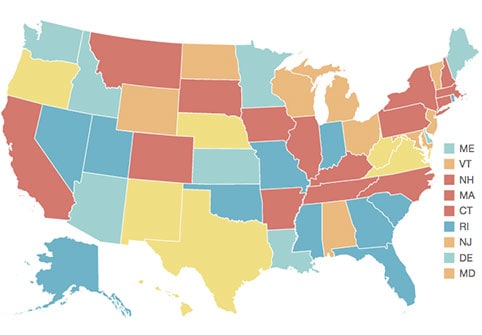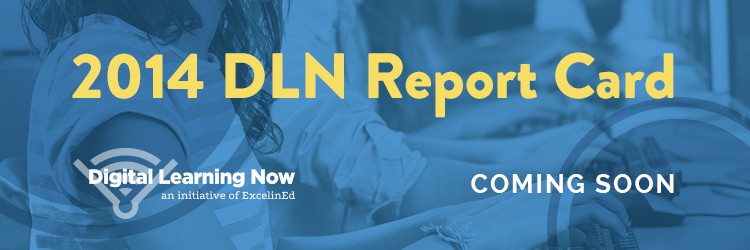DLN Report Card Preview: Creating Innovation Zones in West Virginia

The Digital Learning Report Card examines each state’s progress in implementing policies that give students access to quality digital learning. These advances promise to revolutionize the current K-12 education model by giving students access to far more courses and allowing them to learn in their own way and at their own pace. This annual report card is produced by Digital Learning Now (DLN), an initiative of the Foundation for Excellence in Education (ExcelinEd), Getting Smart Smart Advocacy Partner. The fourth annual report card will be released later this month, grading each state’s 2014 digital education policies against the 10 Elements of High Quality Digital Learning.
We will be highlighting progress and sharing success stories from individual states published in collaboration between Digital Learning Now and Getting Smart. These stories are based on interviews with policymakers and stakeholders. Today we highlight innovation zones in West Virginia. This blog first appeared on The Ed Fly Blog.
Erin Lockett
West Virginia is doing something truly novel. The state is allowing schools and districts to disregard policies and ignore codes.
This approach hasn’t spawned anarchy. Instead, it has allowed schools and teachers to try new innovations in teaching and learning methods. And this is creating new opportunities for students and teachers that can be replicated across the state.
Not every school or district is authorized to snub the rules. Only those selected through a competitive application process by the state board of education are allowed to create these “Innovation Zones.”
The Innovation Zones Act. The intent of West Virginia’s Innovation Zones Act, as amended in WV SB 371 (2012), is ambitious. The Act is designed to:
- Test teaching and learning innovations for replication by other school systems,
- Increase interest and planning within districts and schools around those innovations,
- Improve student performance through innovative approaches to learning and providing schools the flexibility of removing certain policy, rules and interpretive and statutory constraints and
- Expand virtual course options to keep students involved and decrease the number of students dropping out.
“Like every state, West Virginia is on the lookout for new ways to improve education,” explained Gayle Manchin, President of West Virginia’s State Board of Education. “The Innovation Zones Act frees schools and districts to create and share new methods for teaching and learning – methods that focus, without restraint, on the ultimate goal of engaging students and reaching those at risk of dropping out.”
Exploring Innovations. To qualify to be a designated Innovation Zone, a school or district must develop a plan for its innovations and be approved at the local and state level. Once the competitive grant application process is complete, approved schools and districts are authorized to seek waivers of statutes, policies, rules and interpretations over a five-year period as it progresses with implementation of their plans.
 Innovation Zones are a way to explore the potential of education innovations that connect intent and implementation. As designated by the West Virginia Board of Education, an Innovation Zone provides schools support and flexibility so they can collaboratively implement innovations that enhance student learning. Even if those innovations are currently prevented by policy or code.
Innovation Zones are a way to explore the potential of education innovations that connect intent and implementation. As designated by the West Virginia Board of Education, an Innovation Zone provides schools support and flexibility so they can collaboratively implement innovations that enhance student learning. Even if those innovations are currently prevented by policy or code.
“The main barrier was to get schools and districts to think outside the box…It is not enough to say you can waive policy and code – we have sought to give concrete examples of how to use time differently” said Assistant State Superintendent Michele Blatt.
The Act is focused on finding best practices and strategies that address dropout prevention and recovery, and each year the Innovation Zones grants have priority areas. For example, 2013-2014 applicants focused on:
- Comprehensive literacy development,
- Career development,
- Redesign of instruction time,
- Personalized learning through technology and
- Community/school partnerships.
As of January 2015, over 80 grants have been awarded in West Virginia, and the schools who benefit have continued to demonstrate results.
One grant winner is Buffalo High School in Putnam County. The school now has a one-to-one computing program, uses co-teaching and offers embedded credits. Buffalo High is also using the New Tech Model, an instructional approach centered on project-based learning, a culture that empowers students and teachers, and integrated technology in the classroom.
Learning from Thy Neighbor. The overall intent of the Act was to create strategies and methods to help decrease the number of dropouts, and West Virginia hopes other schools and districts learn from Innovation Zones.
These grants create safe zones for educators to try new methods, fail fast, try something different and succeed. If schools around West Virginia can take successful methods and implement them in their classrooms, the return on investment is certainly worth other states taking a look at this model.
Stay tuned for more information on how states are approaching education policy to advance personalized, digital learning.
For more from ExcelinEd, check out:
- DLN Report Card Preview: Accelerating Students in Florida
- DLN Report Card Preview: Seeding Innovation in Ohio
- DLN Report Card Preview: Providing Options for Arizona Students
- EdPolicy Education: New MOOCs from ExcelinEd

Erin Lockett is a Policy Coordinator at The Foundation For Excellence in Education.






James
The main aim of innovation is to provide solutions of existing problems.It is a gradual process and is continuous. It aims at improving the effectiveness and efficiency. Thanks for such a great article.
Keziah
The school now has a one-to-one computing program, uses co-teaching and offers embedded credits. Buffalo High is also using the New Tech Model, an instructional approach centered on project-based learning, a culture that empowers students and teachers, and integrated technology in the classroom.